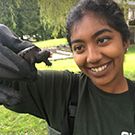Here’s a not-so- fun fact: bird populations are declining around the world. Since 1970, five groups of birds — grassland birds, aerial insectivores, shorebirds, long-distance migrants, and Arctic species — have experienced significant population declines largely driven by factors such as habitat loss and fragmentation, pollution, agricultural practices, and climate change.
That’s why places like the Sydenham River Nature Reserve (SRNR) are so important. This protected forest is part of the Carolinian Zone – one of Canada’s most ecologically rich but threatened region. In a landscape dominated by farms and development, this forest acts as a critical rest stop, breeding ground, and feeding haven for birds on the move.

Tracking Birds One Call at a Time
In addition to habitat conservation, community science projects like Ontario Breeding Bird Atlas (Atlas-3) and eBird help collect powerful data to guide long-term bird conservation.
Atlas-3 is a project with an exciting goal: to map the distribution and relative abundance of Ontario’s approximately 300 species of breeding birds. This massive undertaking is only possible thanks to dedicated volunteers across the province.
But not all birds make themselves easy to find. That’s where Autonomous Recording Units (ARUs) come in. These small audio devices record bird songs and calls in remote areas, capturing soundscape without the interference of humans. They’re especially helpful in hard-to-reach areas and can gather more data than a single person armed with binoculars.

Community – Driven Conservation in Action
On April 5th, 2025, Ontario Nature staff hosted a hands-on breeding bird survey training event with volunteer stewards.
At this event, two ARUs were deployed for the duration of the 2025 breeding bird season, with subsequent training for staff and volunteers to conduct data. Participants also learned how to use mobile apps like Nature Counts and eBird to submit bird observations and contribute even more crucial data to the Atlas.
One goal of this project is to record the presence of forest birds that signal a healthy, thriving ecosystem.
Spectrograms
Ever wonder what a birdsong looks like? With a tool called a spectrogram, we can literally “see” sound. This spectrogram shows a visual representation of sound, with the passage of time occurring horizontally across the image while the frequency is shown vertically and amplitude with growing color intensity (green = lower intensity, yellow = higher intensity):

This spectrogram likely captures both the (A) song sparrow and (B) spring peeper, which are common species in wetland/forested areas in spring. The more structured, repeated patterns with variation shown around the mid-frequency range likely belong to the song sparrow (A), which has a complex, melodic song made up of several phrases. The dense vertical bands on the lower frequencies are likely the spring peeper’s (B) high-pitched, peeping calls. They tend to be short, repeated notes. Together, these two species create a busy yet beautiful spring soundtrack.
Compare the previous spectrogram to the short, repeated calls which are stacked in horizontal bands coming from a bald eagle. Less complex than the song sparrow’s and clearly spaced call repetitions which matches the eagle’s series of high-pithed chirps/squeals.

Spectrograms give us an incredible opportunity to “see” sound in a way that deepens our understanding of avian species and habitat use.
Preliminary ARU Results
From just one ARU deployed at SRNR between April 7- 17th, we detected an impressive lineup of early spring performers including American robins, song sparrows, spring peepers, American crows, red-winged blackbirds, and bald eagles. We also heard many other species: Canada goose, blue jay, brown- headed cowbird, red-bellied woodpecker, gray catbird, belted kingfisher, chipping sparrow, wild turkey, field sparrow, house finch, white-breasted nuthatch, and black-capped chickadee.

A strong mix of warblers, sparrows, woodpeckers and finches tells us one thing: this forest is thriving!
Not only do I find it extraordinary that we can “see” the dynamic sounds of the forest but with ARUs and spectrograms, we can replay nature’s melodic calls whenever we want and know exactly who was singing, when, and which location.
Get Involved
Every chirp, whistle, and peep captured helps us build a clearer picture of how birds are using these protected spaces- and how we can better protect them in return. Atlas-3 project is collaborative effort that not only supports bird conservation but builds local capacity for long-term monitoring and empowers people to be a part of lasting conservation solution.
Want to help? Grab your binoculars, log your sightings on eBird, volunteer for the Ontario Breeding Bird Atlas or become a steward for Sydenham River Nature Reserve.



